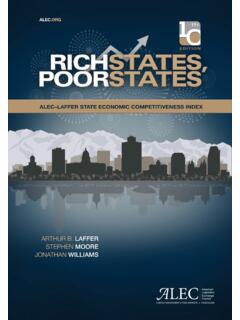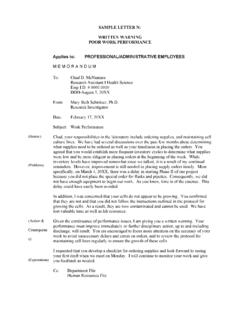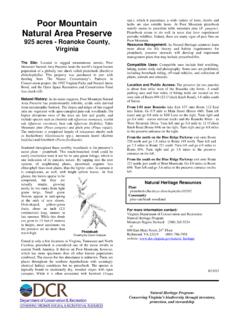Transcription of RICH STATES, POOR STATES Rich States, Poor States
1 I thank the authors of rich STATES , poor STATES for annually publishing this vital economic analysis. Over the years, this publication has been the catalyst for numerous policy reforms that have truly enhanced the wellbeing of hardworking taxpayers across America. The principles outlined within these pages give all STATES a proven roadmap for economic competitiveness. New Hampshire Representative Ken Weyler Chairman, ALEC Center for State Fiscal Reform rich STATES , poor STATES is the go to index for evaluating state economic growth. ALEC s analysis is clear: Lower overall tax burdens lead to greater prosperity. David Brunori Research Professor of Public Policy, The George Washington University As Americans increasingly look to the 50 STATES for leadership in the area of policymaking, rich STATES , poor STATES is an essential guide for those who care about policy solutions that work. While there are numerous ways to rank the STATES today, Laffer, Moore and Williams have done a tremendous job identifying and utilizing the important policy levers that actually matter for the economic growth and financial success of STATES .
2 Rex Sinquefield Co-author, An Inquiry Into the Nature and Causes of the Wealth of STATES 9 780985 37797790000>ISBN 978-0-9853779-7-7 American Legislative Exchange Council2900 Crystal Drive, Suite 600 Arlington, VA STATES , poor STATES 9TH EDITION| ALEC-LAFFER STATE ECONOMIC COMPETITIVENESS INDEX2016 RSPS 112/20/16 4:06 PMRich STATES , poor StatesALEC-Laffer State Economic Competitiveness IndexArthur B. LafferStephen MooreJonathan WilliamsRich STATES , poor StatesALEC-Laffer State Economic Competitiveness IndexArthur B. LafferStephen MooreJonathan WilliamsRich STATES , poor StatesALEC-Laffer State Economic Competitiveness Index 2016 American Legislative Exchange CouncilAll rights reserved. Except as permitted under the United STATES Copyright Act of 1976, no part of this publication may be reproduced or distributed in any form or by any means, or stored in a database or retrieval system without the prior permission of the byAmerican Legislative Exchange Council2900 Crystal Drive, Suite 600 Arlington, VA Arthur B.
3 Laffer, Stephen Mooreand Jonathan Williams, AuthorsISBN 978-0-9853779-7-7 rich STATES , poor STATES : ALEC-Laffer State Economic Competitiveness Index has been published by the American Legislative Exchange Council, America s largest nonpartisan, voluntary membership organiza-tion of state legislators dedicated to the principles of limited government, free markets and federalism. Comprised of nearly one-quarter of the country s state legislators and stakeholders from across the policy spectrum, ALEC members represent more than 60 million Americans and provide jobs to more than 30 million people in the United American Legislative Exchange Council is classified by the Internal Revenue Service as a 501(c)(3) nonprofit and public policy and educational organization. Individuals, philanthropic foundations, corpora-tions, companies, or associations are eligible to support the Council s work through tax-deductible rich STATES , poor StatesAbout the Authors Acknowledgements Foreword Executive Summary 10 Golden Rules of Effective Taxation CHAPTER 1 State of the STATES Americans Continue to Vote with Their Feet Across STATES State Tax Cut Roundup of Actions in 2015 What America s Governors Said About Fiscal Policy in 2016 A Snapshot of Significant Policy Battles in 2016 Addressing the Skeptics Income Taxes Pose Risk to State Budgets State Pension Debt: One of the Biggest Threats to State Finances Keeping Politics Out of Pensions Pension Reform in the Desert Conclusion CHAPTER 2 Right-to-Work is Working for STATES The History of Right-to-Work The Effects of Declining Union Power Unions and the Migration of Businesses, People and Capital Public Sector Unions: Still Going Strong?
4 The Campaign Finance Impact of Declining Union Power The Economic Performance Consequences of Right-to-Work Conclusion CHAPTER 3 Why STATES Shouldn t Tax Death Authors Note State Death Taxes Why Kill the Estate Tax? STATES Losing Income and Revenue as Residents Move to Avoid Death Taxes STATES That Tax Death Estate Taxes Do Not Reduce Income Inequality Conclusion CHAPTER 4 State Rankings: 2016 ALEC-Laffer State Economic Competitiveness Index Appendix: Economic Outlook Methodology ivvviviiix125781314171719192324263134353 739434445464748505155108 Table of iiiAbout the AuthorsDR. ARTHUR B. LAFFERA rthur B. Laffer is the founder and chairman of Laffer Associates and Laffer Investments, and many publications have named him The Father of Supply-Side Economics. Dr. Laffer served as a member of President Reagan s Economic Policy Advisory Board for both terms and also advised Prime Minister Margaret Thatcher on fiscal policy in the during the 1980s. He has been a faculty member at the University of Chicago, University of Southern California and Pepperdine University.
5 In March 1999, he was noted by Time Magazine as one of the Century s Greatest Minds for his invention of the Laffer Curve, which has been called one of a few of the advances that powered this extraordinary century. He has received many awards for his economic research, including two Graham and Dodd Awards from the Financial Analyst Federation. He graduated from Yale with a Bachelor s degree in economics in 1963 and received both his MBA and in economics from Stanford MOORES tephen Moore, who formerly wrote on the economy and public policy for The Wall Street Journal, is a distinguished visiting fellow with the Project for Economic Growth at The Heritage Foundation. Moore founded and served as the president of the Club for Growth and founded the Free Enterprise Fund. Over the years, Moore has served as a senior economist at the Congressional Joint Economic Committee and as a senior economics fellow at the Cato Institute. He was also a consultant to the National Economic Commission in 1987 and research director for President Reagan s Commission on Privatization.
6 Moore is a Fox News contributor along with writing regularly for National Review, Forbes, Investor s Business Daily, The Washington Times and the Orange County Register. Moore holds a master s of arts in economics from George Mason University. He has authored numerous books, including Who s the Fairest of Them All, It s Getting Better All the Time, Still an Open Door and An Inquiry into the Nature and Causes of the Wealth of STATES . JONATHAN WILLIAMSJ onathan Williams is the vice president for the Center for State Fiscal Reform and chief economist at the American Legislative Exchange Council (ALEC), where he works with state policymakers, congressional leaders and members of the private sector to develop fiscal policy solutions for the STATES . Prior to joining ALEC, Williams served as staff economist at the nonpartisan Tax Foundation, authoring numerous tax policy studies. Williams s work has appeared in many publications, including The Wall Street Journal, Forbes and Investor s Business Daily.
7 He is a columnist for Tax Analysts, the leading provider of tax news and analysis for the global community. He has written for the Ash Center for Democratic Governance and Innovation at Harvard s Kennedy School of Government. In addition, Williams was a contributing author of In Defense of Capitalism (Northwood University Press). Williams has testified before numerous legislative bodies and spoken to audiences across America. He is a frequent guest on talk radio shows and has appeared on numerous television outlets, including the PBS NewsHour, Fox Business News and Bloomberg. Williams was also the recipient of the prestigious Ludwig von Mises Award in rich STATES , poor vAcknowledgementsWe wish to thank the following for making this publication possible: First, our sincere thanks go to the Searle Freedom Trust for their generous support of this research. Next, we thank Lisa B. Nelson, Bill Meierling, Ashley Varner, Ashley Pratte, Christine Phipps, Nathan Brinkman, Theodore Lafferty, Kati Siconolfi, Elliot Young, Christine Smith, Joe Horvath, Joel Griffith, Anthony Iafrate, James Kennedy, Tony Bergida and the professional staff of the American Legislative Exchange Council for publishing this in a timely manner.
8 We also appreciate the research assistance of Nicholas Drinkwater, John Burke and Julia Roseman. We hope these research findings will continue to be a good resource for America s state legislators and members of the public interested in pro-growth tax addition, we now require worker training and drug testing for people on food stamps because true freedom and prosperity do not come from the mighty hand of the government; they come from empowering people to live their own lives and control their own destinies through the dignity that comes from work. And last year, Wisconsin became the 25th right-to-work state. Giving work-ers the freedom to choose undoubtedly gives em-ployers yet another reason to consider expanding or relocating in Wisconsin, and it sends a powerful message across the nation that we truly are Open for Business. The results of our reforms have been overwhelm-ingly positive for Wisconsin families. Today, our un-employment rate is percent (the lowest since 2001), businesses are expanding and creating jobs and more people are working in Wisconsin this year than at any time in our history.
9 We are also proud to have climbed from 30th in 2011 to 9th this year in the rankings of rich STATES , poor STATES . While all these indicators are incredibly positive, there is more work to be done. If our reforms can work in a blue state like Wisconsin, they can work anywhere in America. On behalf of the State of Wisconsin, my sincere thanks to Dr. Art Laffer, Stephen Moore, Jonathan Williams and the American Legislative Exchange Council for their continued efforts to promote pro-growth policies across America. Sincerely, Scott Walker Governor of Wisconsinvi rich STATES , poor StatesABOUT THE AUTHORSF orewordhen we took office in 2011, Wisconsin faced a $ billion budget deficit, our unemployment rate was percent and we had lost more than 133,000 jobs. We got to work immediately to deliver real change for the people of Wisconsin, and we ve delivered real re-sults.
10 One of my first acts as governor was to de-clare Wisconsin Open for Business, and that s ex-actly what we ve done. We cut taxes by more than $ billion for individuals, employers and prop-erty. In fact, property taxes are actually lower to-day than when we took office. The budget deficit? Gone. We turned it into multiple surpluses without raising taxes, and our state s rainy day fund is now 165 times larger than when we took office. We also instituted big, bold reforms. In 2011, we eliminated collective bargaining for public em-ployees and required them to contribute to their pension and pay a little more for their health care benefits. This important reform known as Act 10 has already saved our state and local governments some $5 billion, but it s more than just about sav-ing money. Our school districts can now hire based on merit and pay based on performance. This means we can put the best and the brightest in our classrooms and we can pay to keep them there.











